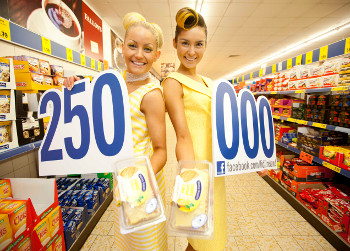Connect with your customers

How important is social media for convenience stores and supermarkets? Can it encourage customers to come to your shop? Can it drive sales? Many questions still surround social media; Anne Brady looks for the answers
18 February 2014

AT A GLANCE: SOCIAL MEDIA
• 1 billion global users
• 2.3 million Irish users
• 1.7 million use their phones
• 70% Irish users go onto the site daily
• Monday is the most popular day in Ireland
(Source: Irish Digital Consumer Report 2013)
• 600,000 Irish users
• Wednesday busiest day
• 1 million tweets sent each day
• 10-11pm busiest hour in Ireland
• 46% of 25-34 year olds use the site
(Source: Irish Digital Consumer Report 2013)
As a business owner it can be difficult to determine if social media is warranted as a medium for growth. However, with 2.3 million Irish consumers on Facebook and 600,000 on Twitter it makes a good case. Social media is here to stay and no matter what the size or the sector, it can be used to build awareness and potentially boost sales. Like anything in business, the more time spent initially developing a strategy and its execution the greater the return on investment.
Growing engagement
Larger organisations undoubtedly have more resources available to pursue a social media strategy. Some of the larger grocery retailers have made a big impact, most notably Lidl. It is ranked number two in terms of popular brands on Facebook. That is in comparison to Tesco Ireland, at number 11, Centra at number 12, Spar Ireland at number 15 and SuperValu Ireland at 25* (at the time of going to print). But it’s important to note that it’s not all about the number of fans; it’s about engaging customers, listening to what they have to say and then providing value. Why is this important? Because according to Amas.ie, 51% of Irish consumers are talking about brands on social media. Of these, 74% are talking about offers and promotions, 15% are posting praise and another 15% are posting complaints. Retailers involved in the conversation can inform customers about their offers, thank them for their praise or rectify any complaints.
Using head office
Lidl has been recognised as a retailer that has hit the nail on the head when it comes to social media and has a number of social media awards to prove it. It is also the first Irish supermarket to reach 250,000 fans on Facebook. Not to rest on its laurels, Lidl celebrated the achievement by offering Facebook fans free cake if they presented a printed coupon in-store. In this case, an online medium was effectively used to drive footfall into stores. The page continues to grow and now has well over 365,900 fans. The strong presence on social media is reflective of the increase in the Irish grocery market share Lidl has obtained over the last number of years, which was at 6.9% in November 2013.
Centra Ireland has used Twitter to great effect. For Blue Monday of January this year, it ran a campaign using the hashtag #Centra1c offering customers a one cent coffee or tea with any purchase. It was a very proactive campaign, engaging users through their mobile devices, while at work, at home and at times when they were using their social networks the most. Centra tweeted the promotion throughout the day, earning over 76 retweets within its Twitter community and earning over 428,000 impressions to potential customers. Facebook served as a secondary channel with 2,853 users directly interacting with the posts and the campaign reached over 279,000 potential customers. Joyce Hosford of Centra said: "This campaign received overwhelmingly positive sentiment on social media, really highlighting the strong connection between our social communications and footfall in Centra stores nationwide."
The independents
The benefit of social media is that it’s free. The downside is that it takes time and quite a bit of time – if not tackled in the right manner. For independent retailers and smaller businesses, that don’t have the resources of a head office, this is a challenge. However, like any other part of the business, an effective strategy for social media will make more efficient use of time. Achievable and realistic goals put down from day one will direct the activities. The Organic Supermarket, based in Blackrock, Dublin took social media by storm. The retailer has over 27,000 followers on its Facebook page generated by applying some very creative ideas to engage with fans. One such idea was a competition to ask people what the next competition should be. This went viral and was shared by over 40,000 people. Another competition asked people to guess the number of jellybeans in a jar which was shared over 37,000 times. Clever and simple ideas can engage an audience and build awareness of a store. Ardkeen Quality Food Store is a locally owned and managed store in Dunmore, Waterford. It has just over 2,400 users who actively engage with the brand. Its focus is on products in the store, suppliers of the shop’s produce, offers and promotions. To this end, its customers can build up better relationships with products, suppliers and ultimately the store.
What the expert says
Anthony Quigley is a leading digital marketer and founder of the Digital Marketing Institute. He says the first priority is finding your customers. "The challenge for any business is to figure out where the customers are. Like any part of the business, it’s all about what’s happening with the customers. For example, there is no point in setting up a Facebook page if your potential customers are on Twitter." The research must be done before jumping in. Quigley says: "If I was advising a retailer, I would suggest going onto Twitter or Facebook and listening to what’s going on. You can get set up alerts to tell you who is talking about what and where they are saying it. After a month or two decide what you’re going to do."
Once you know who your audience is, Quigley says to provide them with information. "Be a giver of information and people will be more willing to give back to you. If your customers want recipes, give them recipes. If they want offers let them hear what’s on offer in the store. The more they hear, the more they know about your business and the more they will want to come and check it out. Providing your customers with valuable information can be a very effective strategy," says Quigley. However, social media does come with warnings. "I would advise retailers not to try everything," says Quigley. "Because if you try everything, your efforts will be diluted and you won’t be engaging successfully on any platform."
The global network
So what does Quigley see as the future of social media for business? "We’re still in an immature market. There are certain industries that are well advanced, such as hospitality and finance, but most industries are trying to catch up and figure it out. Social media is fragmenting and growing and becoming an integral part of the marketing mix."
There are opportunities for grocery retailers to benefit from taking a step into the unknown. Even though social media is a global network, it can still be used in a very local way. So find your niche and talk to your customers in a real and genuine way.
*Socialbakers.com, Facebook Statistics



 Print
Print






Fans 0
Followers